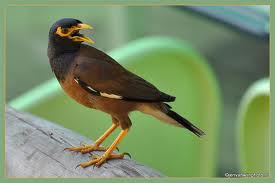
The travel column this week looks at some very unwelcome visitors to Zimbabwe: the common or Indian myna bird, branded by the International Union for the Conservation of Nature (IUCN) as one of the world’s 100 most invasive species and identified in Australia as their most serious pest problem.
Travel with Dusty Miller
They’ve reportedly already arrived in vast tracts of Zimbabwe, now read on: Zimbabweans are warned to be on the lookout for Indian myna birds, the common myna, often seen in cages kept as pets throughout the world.
Originally native to India and south and central Asia, myna birds (their scientific name is Acridotheres tristis) were taken to South Africa, mainly as pets by Indians settling in Natal, around Durban, in 1902 and many others travelled in the rigging of ocean-going dhows and vessels sailing between India and the African coast.
Many of these escaped, or were released into the wild and they have been firmly established along much of South Africa’s east coast and in the Transvaal now for more than 100 years.
Geoff Lowe of Birdlife Zimbabwe has issued flyers depicting the medium-sized bird — IUCN says it poses an impact threat on biodiversity, agriculture and human interests—across various well-known birding sites, including the offices of the Makuvisi Woodlands, the rolling 275 hectare nature reserve, in Harare’s eastern surburbs.
Reached Zimbabwe The leaflet says the birds were introduced to South Africa more than a century ago, but have fairly recently begun a range of expansion and have already reached Zimbabwe.
Mynas have been spotted in Beitbridge, Bulawayo, Chiredzi, Masvingo and they have recently been identified in the world-famous Hwange National Park in Matabeleland North. “They may have already reached Harare and elsewhere,” say Wildfire, who appeal for details of first sightings of the birds by ornithologists, birders and members of the general public.
- Chamisa under fire over US$120K donation
- Mavhunga puts DeMbare into Chibuku quarterfinals
- Pension funds bet on Cabora Bassa oilfields
- Councils defy govt fire tender directive
Keep Reading
Indian myna birds are very aggressive. They are known to evict other birds from their established nests and often remove chicks, which consequently die, or eggs — which fall to the ground and are smashed — from the nests.
They pose a definite threat to Zimbabwe’s indigenous birds, especially those which nest in holes in trees, such as members of the barbet family and starlings. They can also decimate fruit production.
Extremely colonial, the males will defend huge areas of countryside against rival species, which has a negative effect on those birds’ efforts to reproduce.
In Australia — where they were introduced to kill insects eating food crops, but their numbers escalated beyond imagination — they are often called “flying rats” because they scavenge on similar detritus as rodents.
I saw, watched and photographed then in Adelaide, South Australia, recently, where they are almost the most commonly seen bird. And not for nothing is Adelaide dubbed Seagull City. They also pinched crumbs off and below my table when I ate breakfast al fresco at the Le Meridien hotel in Dubai, en route to Australia and I’ve also snapped them in RSA, Mauritius and the Seychelles.
Mynas targeted South Africa’s fairly strict by-laws pertaining to the shooting of most wild creatures specifically exclude myna birds and they are often the target of farmers and urban dwelling marksmen. In Hawaii, the myna is named as the fourth most serious avian pest to that state’s vital fruit industry.
Although they may prefer urban habitats, there is evidence that they are increasingly settling in natural woodland environments. They are most often seen in pairs or small groups, but where well established, they will roost in very large numbers.
They frequently forage on the ground and will eat insects, worms, fruits, seed and household scraps, nesting in other birds’ nests or under the eaves of buildings.
The Birdlife Zimbabwe flyer says: “Indian mynas spread rapidly. They are unwanted and we are advised to dispose of any we see, if we can.” They ask interested individuals who spot mynas to contact them with information as to date, time and place where they were first seen; number of mynas observed together, and their behavior, especially inter-actions observed with other birds.
Geoff Lowe of Birdlife Zmbabwe can be contacted at [email protected]
(Many years ago . . . try nearly 50…I was sitting in a pub in Wakefield, West Yorkshire in the UK, with a chum of mine called James Arthur Clarke. As we steadily sipped and supped pints of best bitter in pre-breathalyzer days, there was a piercing shriek of (coincidentally) “Jii . . . mm . . .yyy . . . Ji . . . mm . . . yyy!” My pal said “That’s clever; I never saw your lips move!” I explained that it wasn’t me calling him but the landlady’s pet myna bird in a wicker-work cage behind the bar.
“Miner bird?” he asked. “Why do they call them that?” I couldn’t resist a wind-up and lied through my teeth, claiming that in India, where they originated from, the birds were trained to go down coal pits, returning above ground with a small lump of coal in their beaks each journey!
Jimmy was sometimes a couple of chips short of a fish supper and responded: “Course they’d never get away with that here, the RSPCA and bird society would soon put a stop to that!” Boom! Boom!
(Mukuvisi Woodlands, Hillside Road, east off Glenara, Harare, is open to the public daily from dawn to dusk. Tomorrow morning there’s a fundraising fun dog walk and run for the SPCA; great value breakfast, brunch or lunch at the coffee shop there.) [email protected]











